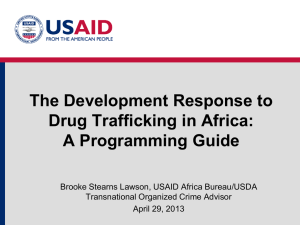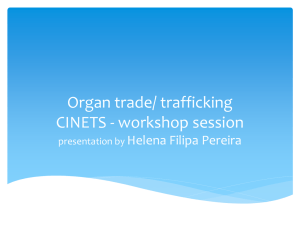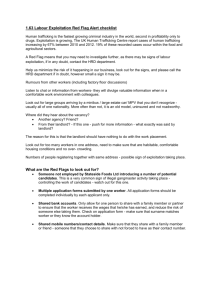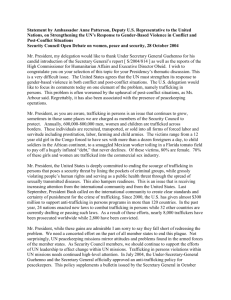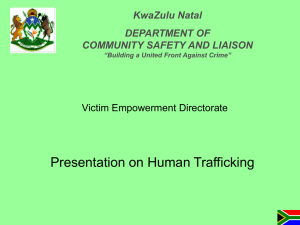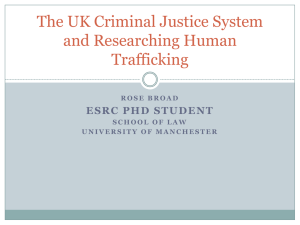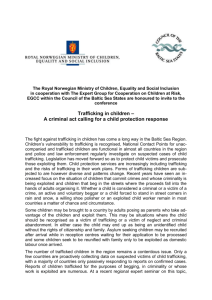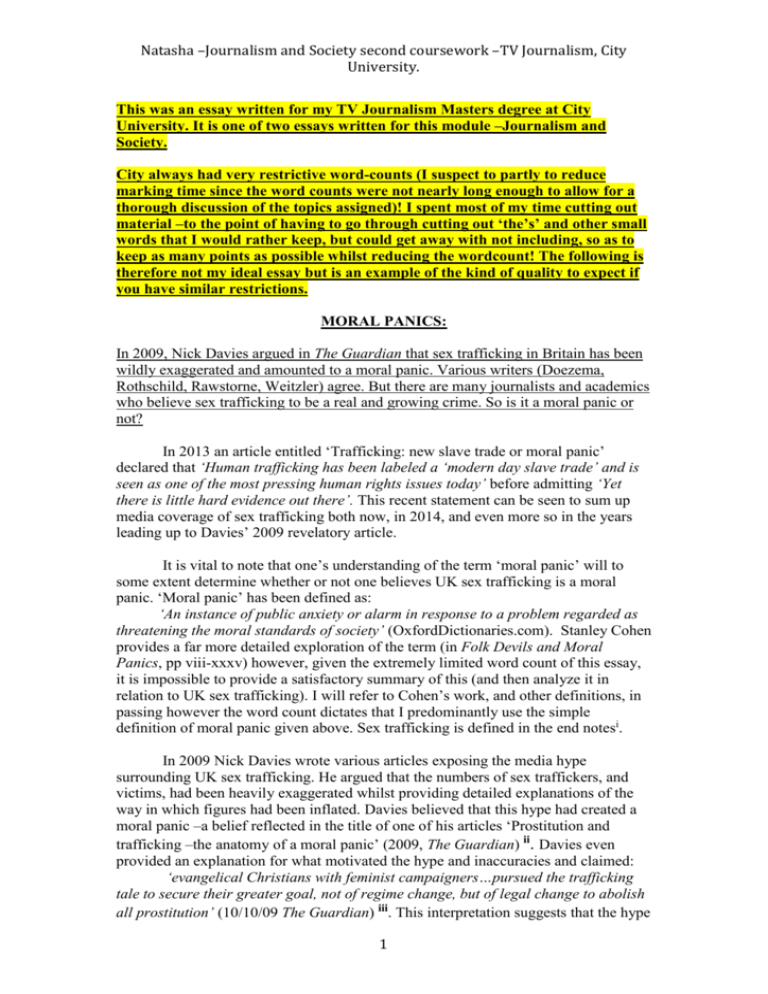
Natasha –Journalism and Society second coursework –TV Journalism, City
University.
This was an essay written for my TV Journalism Masters degree at City
University. It is one of two essays written for this module –Journalism and
Society.
City always had very restrictive word-counts (I suspect to partly to reduce
marking time since the word counts were not nearly long enough to allow for a
thorough discussion of the topics assigned)! I spent most of my time cutting out
material –to the point of having to go through cutting out ‘the’s’ and other small
words that I would rather keep, but could get away with not including, so as to
keep as many points as possible whilst reducing the wordcount! The following is
therefore not my ideal essay but is an example of the kind of quality to expect if
you have similar restrictions.
MORAL PANICS:
In 2009, Nick Davies argued in The Guardian that sex trafficking in Britain has been
wildly exaggerated and amounted to a moral panic. Various writers (Doezema,
Rothschild, Rawstorne, Weitzler) agree. But there are many journalists and academics
who believe sex trafficking to be a real and growing crime. So is it a moral panic or
not?
In 2013 an article entitled ‘Trafficking: new slave trade or moral panic’
declared that ‘Human trafficking has been labeled a ‘modern day slave trade’ and is
seen as one of the most pressing human rights issues today’ before admitting ‘Yet
there is little hard evidence out there’. This recent statement can be seen to sum up
media coverage of sex trafficking both now, in 2014, and even more so in the years
leading up to Davies’ 2009 revelatory article.
It is vital to note that one’s understanding of the term ‘moral panic’ will to
some extent determine whether or not one believes UK sex trafficking is a moral
panic. ‘Moral panic’ has been defined as:
‘An instance of public anxiety or alarm in response to a problem regarded as
threatening the moral standards of society’ (OxfordDictionaries.com). Stanley Cohen
provides a far more detailed exploration of the term (in Folk Devils and Moral
Panics, pp viii-xxxv) however, given the extremely limited word count of this essay,
it is impossible to provide a satisfactory summary of this (and then analyze it in
relation to UK sex trafficking). I will refer to Cohen’s work, and other definitions, in
passing however the word count dictates that I predominantly use the simple
definition of moral panic given above. Sex trafficking is defined in the end notesi.
In 2009 Nick Davies wrote various articles exposing the media hype
surrounding UK sex trafficking. He argued that the numbers of sex traffickers, and
victims, had been heavily exaggerated whilst providing detailed explanations of the
way in which figures had been inflated. Davies believed that this hype had created a
moral panic –a belief reflected in the title of one of his articles ‘Prostitution and
trafficking –the anatomy of a moral panic’ (2009, The Guardian) ii. Davies even
provided an explanation for what motivated the hype and inaccuracies and claimed:
‘evangelical Christians with feminist campaigners…pursued the trafficking
tale to secure their greater goal, not of regime change, but of legal change to abolish
all prostitution’ (10/10/09 The Guardian) iii. This interpretation suggests that the hype
1
Natasha –Journalism and Society second coursework –TV Journalism, City
University.
was motivated by morality and was a reaction against ‘a problem regarded as
threatening the moral standards of society’ -it therefore fits the Oxford Dictionaries’
definition of a moral panic.
Many writers, (such as Jo Doezema, Natalie Rothschild, Tom Rawstorne and
Ronald Weitzler) agreed that the issue was hyped to the extent of creating a moral
panic (see end notes) iv. Rawstorne specifically declared that ‘a litany of wild claims
contributed to a moral panic’ (‘The myth of Britain’s foreign sex slaves’). They
stressed that many of the prostitutes found during police raids were not being held
against their will but were instead choosing to work. This meant that they could not
be classified as trafficking victims. Some oppose this logic by arguing that there is
little difference between prostitutes and sex trafficked victims since prostitution is
never really a choice v.
In opposition to Davies, many such as Alexandra Topping vi, James Kirkup vii,
Mark Townsend viii, Chahal Milmo, Nigel Morris, Amelia Gentleman, Sam
Underwood and Denis McShane wrote articles to emphasize their view that sex
trafficking is significant and growing crime (please see end notes for their arguments
and quotes). These may be seen to encourage, or reflect, a moral panic. The
publication of victims’ stories have also supported the argument that sex trafficking is
a problem in Britain whilst encouraging public concern (or moral panic). Ardita Kraja
is an example of a trafficking victim who chose to reveal her story (The Guardian
23/10/09). Other victims followed suit (usually anonymously) and journalists, such as
Mark Townsend and Amelia Gentleman, reported their stories and so encouraged
public concern.
One might question whether the average member of the public experiences/d
‘anxiety and alarm’ about sex trafficking and to what extent? Or whether public
concern is the same as a moral panic? Cohen (xxxvi) notes that ‘the term ‘panic’ has
caused unnecessary trouble’ since it is associated with irrationality and being out of
control –however he goes on to claim that ‘After at first being apologetic and
accepting the downgrade of ‘panic’ to a mere metaphor, I remain convinced that the
analogy works’ (xxvii). He says that media driven narratives also have certain criteria
which typically identify them as moral panics:
‘drama, emergency and crisis; exaggeration; cherished values threatened; an
object of concern, anxiety and hostility; evil forces or people to be identified and
stopped; the eventual sense of the episodic and transitory’ (xxvii). Most, if not all, of
these were present in the media coverage of sex trafficking in the lead up to Davies’
2009 article.
Some, (for example charities such as Unseen, Stop the Traffick and the
Human Trafficking Foundation), would argue that sex trafficking is still a large
problem in Britain and so not ‘transitory’ –this undermines the claim that the issue
(and by implication moral panic if you use the OxfordDictionaries’ definition) has
been and gone. Indeed, in 2014, the issue (and especially child trafficking) is still
receiving media attention -–for example on the 18th of February 2014 the BBC
published an article claiming that ‘The number of UK-born children thought to have
been trafficked for sexual exploitation more than doubled last year’ (‘UK child sex
abuse doubles –National Crime Agency’)ix. The findings and figures in the article
may seem to prove that sex trafficking is still as much of an issue, if not more of one,
than it was around 2007-2009. The figures are however more likely to be correct and
2
Natasha –Journalism and Society second coursework –TV Journalism, City
University.
not exaggerated as before, and just because there is a moral issue, this does not mean
that it is necessarily a moral panicx. These are key distinctions and in my opinion,
although the issue is still unresolved, the characteristics of moral panic have
dissipatedxi.
How we interpret the word ‘moral’ in ‘moral panic’ is also vital (see endnote)
. Likewise, we should question whether a moral panic requires a large proportion of
the public (perhaps even a majority) to be concerned? This is not clarified in the
simple definition above however it is implied and a necessary element xiii. The simple
(OxfordDictionaries.com) definition is therefore a useful guide but inadequate. In the
original definition of the term (provided by Goode and Ben-Yehuda and cited by
Cohen, viii), ‘consensus’ is clearly stated as one of the elements of a moral panic.
Consensus is defined as ‘a widespread agreement (not necessarily total) that the
threat exists, is serious and that ‘something should be done’ (Cohen). I believe that
there was this widespread consensus about the prevalence and immorality of sex
trafficking around 2007-2009 however Davies’ articles, and similar ones that
followed, destroyed it and so the moral panic.
xii
Other elements of a moral panic in Goode and Ben-Yehuda’s original
definition include:
‘Concern (as opposed to fear) about the potential or imagined
threat…Hostility -moral outrage towards the actors…who embody the problem and
agencies… who are ‘ultimately’ responsible… Disproportionality: an exaggeration of
the number or strength of cases, in terms of the damage caused, moral offensiveness,
potential risk if ignored. Public concern is not proportionate to objective harm…
Volatility –the panic erupts and dissipates suddenly without warning’ (Cohen, xxii).
All of these, with the possible exception of ‘volatility’, fit the treatment of sex
trafficking around 2007-2009.
To conclude I believe that there was a period of time (approximately 20072009) when sex trafficking received a lot of media coverage and caused a moral
panic. This was before Davies (in 2009), and others, revealed how disproportionate
the media treatment of the issue had been –after which point the media hype calmed
down and the moral panic dissipated. Sex trafficking, in 2014, is not a moral panicxiv.
Ultimately, whether one believes there was, or is, a moral panic depends on one’s
definition of the term ‘moral panic’, as well as other definitions and subjective
perspectives. Simple definitions leave too much open to debate and interpretation so
more precise definitions are helpful. UK sex trafficking still occurs however I do not
believe that it provokes the moral panic that it once did. ‘Compassion fatigue’ may
partially explain why sex trafficking is no longer the moral panic that it once wasxv.
Word count: 1370 including references. (1381=word limit as allowed 1250 +
10%).
Please see vital end notes –thank you.
3
Natasha –Journalism and Society second coursework –TV Journalism, City
University.
REFERENCES:
Anonymous, October 2007, ‘I was sold for 2,000 euros’, BBC News.
http://news.bbc.co.uk/1/hi/uk/7026018.stm
Battle of Ideas (Student Union), 31st October, 2013, ‘Trafficking: new slave
trade
or
moral
panic’,
http://www.battleofideas.org.uk/2010/session_detail/4117
BBC Website (article), 18th February 2014, ‘UK child sex abuse trafficking
doubles –National Crime Agency’, http://www.bbc.co.uk/news/uk-26234092
Cohen, S., 2002. Folk Devils and Moral Panics. 3rd ed. London: Routledge.
Davies, N., 20th October 2009. ‘Prostitution and trafficking –the anatomy of a
moral panic’, The Guardian.
http://www.guardian.co.uk/uk/2009/oct/20/trafficking-numbers-womenexaggerated
Davies, N, 20th October 2009. ‘Inquiry fails to find single traffickers who
forced anybody into prostitution’, The Guardian.
http://www.guardian.co.uk/uk/2009/oct/20/government-trafficking-enquiryfails
Davies, N, 19th October 2009. ‘How misinformation flooded the se trafficking
industry’, http://www.nickdavies.net/2009/10/19/how-misinformationflooded-the-sex-trafficking-story/ NickDavies.net
Doezema, J., Winter 2000, ‘Loose Women or Lost Women? The reemergence of the myth of ‘white slavery’ in contemporary discourses of
‘trafficking in women’, Vol. 18/1, Gender Issues, pp. 23-50.
http://www.walnet.org/csis/papers/doezema-loose.html
Gentleman, A., 19th April 2011, ‘Katya’s story: trafficked to the UK, sent
home
to
torture’,
The
Guardian.
http://www.guardian.co.uk/law/2011/apr/19/sex-trafficking-uk-legal-reform
Goode, E & Ben-Yehuda, N, 1994. Moral Panics: the Social Construction of
Deviance. Oxford: Blackwell.
Hope for Justice (trafficking) Charity, http://hopeforjustice.org.uk
4
Natasha –Journalism and Society second coursework –TV Journalism, City
University.
Human Trafficking Foundation –charity,
http://www.humantraffickingfoundation.org Specifically:
http://www.humantraffickingfoundation.org/whats-issue/case-studies/sextrafficking
Eurostat –European Commission (2013) Trafficking in Human Beings,
http://ec.europa.eu/dgs/home-affairs/what-isnew/news/news/2013/docs/20130415_thb_stats_report_en.pdf
Kirkup, J., 2nd July 2008, ‘British teenage girls forced into prostitution by
people
traffickers’,
The
Telegraph.
http://www.telegraph.co.uk/news/uknews/2236100/British-teenage-girlsforced-into-prostitution-by-people-traffickers.html
Kraja, A, ‘23rd October 2009, ‘Trafficking is no myth –I endured it’, The
Guardian. http://www.guardian.co.uk/commentisfree/2009/oct/23/traffickingprostitution-women-myth
Leask, D., 3rd July 2008, ‘Crackdown on sex trafficking leads to rescue of 59
women’, The Herald. http://www.heraldscotland.com/crackdown-on-sextrafficking-leads-to-rescue-of-59-women-1.883839
MacShane, D., 21st October 2009. ‘Sex trafficking: a futile war of statistics’,
The Guardian.
MacShane, D., 6th September 2010, ‘Britain’s sex trade needs tackling’, The
Guardian. http://www.guardian.co.uk/commentisfree/2010/sep/06/sex-slavetrafficking
MacShane, D. and Adams, N, 21st October 2009, Newsnight, BBC2.
Milmo, C. & Morris, N., 3rd July 2008, ’18,000 women and children trafficked
into
UK
sex
trade’,
The
Independent.
http://www.independent.co.uk/news/uk/crime/18000-women-and-childrentrafficked-into-uk-sex-trade-859106.html
OxfordDictionaries.com:http://www.oxforddictionaries.com/definition/english
/moral-panic
Rawstorne, T., 13th November 2009, ‘The myth of Britain’s foreign sex
slaves’,
Daily
Mail.
http://www.dailymail.co.uk/news/article1227418/SPECIAL-INVESTIGATION-The-myth-Britains-foreign-sexslaves.html
Rothschild, N., 30th April 2009, ‘More evidence that ‘sex trafficking’ is a
myth’, Spiked. https://network23.org/bristolnoborders//2009/04/30/moreevidence-that-sex-trafficking-is-a-myth/
5
Natasha –Journalism and Society second coursework –TV Journalism, City
University.
“Stephanie”, 14th April 2008, ‘A sex-traffic victim’s story’, The Argus,
http://www.theargus.co.uk/magazine/interview/2194813.a_sextraffic_victims_
story/
Stop the Traffick charity, https://www.stopthetraffik.org/uk
The Advocates for Human Rights, (Sex Trafficking definition and
explanation)
http://www.theadvocatesforhumanrights.org/what_is_human_sex_trafficking
The Advocates for Human Rights, (Sex Trafficking definition and
explanation)
http://www.theadvocatesforhumanrights.org/what_is_human_sex_trafficking
The Global Slavery Index, 2013,
http://www.globalslaveryindex.org/
United Kingdom index rank 160 –estimated number enslaved 4,100-4,600.
(This is not exclusively sex trafficking).
Topping, A., 17th January 2011, ‘Child sex trafficking in UK on the rise with
even
younger
victims
targeted’,
The
Guardian.
http://www.guardian.co.uk/society/2011/jan/17/child-trafficking-uk-rise
Townsend, M., 6th February 2011, ‘Sex trafficking in the UK: one woman’s
horrific story of kidnap, rape, beatings and prostitution’, The Observer.
http://www.guardian.co.uk/uk/2011/feb/06/sex-traffick-romania-britain
Townsend, M., 17th April 2011, ‘ex-trafficked women’s charity Poppy Project
in
danger
as
funding
withdrawn’,
The
Observer.
http://www.guardian.co.uk/society/2011/apr/17/prostitution-human-trafficking
Townsend, 14th May 2011, ‘Trafficking victims lured back to the UK: locked
up
and
raped
at
£30
a
time’,
The
Guardian.
http://www.guardian.co.uk/law/2011/may/14/trafficking-victims-lured-toengland-locked-up-and-raped
Underwood, S., 13th April 2008, ‘Sex slaves in Brighton and Hove’, The
Argus.
http://www.theargus.co.uk/news/2193144.0/?act=complaint&cid=1415640
United Nations -UNODC (2012) Global Report on Trafficking in Person
http://www.unodc.org/documents/data-andanalysis/glotip/Trafficking_in_Persons_2012_web.pdf
Weitzler, R., September/October 2005, ‘The growing moral panic over
prostitution and sex trafficking,’ The Criminologist, Vol. 30/5.
http://www.bayswan.org/traffick/Weitzer_Criminologist.pdf
BIBLIOGRAPHY:
6
Natasha –Journalism and Society second coursework –TV Journalism, City
University.
Anonymous, October 2007, ‘I was sold for 2,000 euros’, BBC News.
http://news.bbc.co.uk/1/hi/uk/7026018.stm
Battle of Ideas (Student Union), 31st October, 2013, ‘Trafficking: new slave
trade
or
moral
panic’,
http://www.battleofideas.org.uk/2010/session_detail/4117
BBC Website (article), 18th February 2014, ‘UK child sex abuse trafficking
doubles –National Crime Agency’, http://www.bbc.co.uk/news/uk-26234092
Boff, A., 2013, London Assembly, Shadow City –Exposing human trafficking
in Everyday London, http://glaconservatives.co.uk/wpcontent/uploads/2013/10/Shadow-City.pdf
Cohen, S., 2002. Folk Devils and Moral Panics. 3rd ed. London: Routledge.
Council of Europe, GRETA –Group of Experts on Action against Trafficking
in Human Beings –‘Report concerning the implementation of the Council of
Europe Convention on Action against Trafficking in Human Beings by the
United Kingdom’, 2012:
http://www.coe.int/t/dghl/monitoring/trafficking/Docs/Reports/GRETA_2012
_6_FGR_GBR_en.pdf (from
http://www.coe.int/t/dghl/monitoring/trafficking/Docs/Monitoring/Country_R
eports_en.asp)
Davies, N., 20th October 2009. ‘Prostitution and trafficking –the anatomy of a
moral panic’, The Guardian.
http://www.guardian.co.uk/uk/2009/oct/20/trafficking-numbers-womenexaggerated
Davies, N, 20th October 2009. ‘Inquiry fails to find single traffickers who
forced anybody into prostitution’, The Guardian.
http://www.guardian.co.uk/uk/2009/oct/20/government-trafficking-enquiryfails
Davies, N, 19th October 2009. ‘How misinformation flooded the se trafficking
industry’, http://www.nickdavies.net/2009/10/19/how-misinformationflooded-the-sex-trafficking-story/ NickDavies.net
Doezema, J., Winter 2000, ‘Loose Women or Lost Women? The reemergence of the myth of ‘white slavery’ in contemporary discourses of
‘trafficking in women’, Vol. 18/1, Gender Issues, pp. 23-50.
http://www.walnet.org/csis/papers/doezema-loose.html
Gentleman, A., 19th April 2011, ‘Katya’s story: trafficked to the UK, sent
home
to
torture’,
The
Guardian.
http://www.guardian.co.uk/law/2011/apr/19/sex-trafficking-uk-legal-reform
7
Natasha –Journalism and Society second coursework –TV Journalism, City
University.
Goode, E & Ben-Yehuda, N, 1994. Moral Panics: the Social Construction of
Deviance. Oxford: Blackwell.
GRETA (2012) Report concerning the implementation of the Council of
Europe Convention against Trafficking in Human Beings by the United
Kingdom, Sept 2012:
http://www.coe.int/t/dghl/monitoring/trafficking/Docs/Reports/GRETA_2012
_6_FGR_GBR_en.pdf
Hope for Justice (trafficking) Charity, http://hopeforjustice.org.uk
Handbook for Diplomatic and Consular Personnel on how to assist and
protect victims of human trafficking, 2001, Stockholm:
http://www.iom.md/attachments/110_CBSS_TFTHB_Handbook_for_Diplomatic_and_Consular_Personnel.pdf
Human Trafficking Foundation –charity,
http://www.humantraffickingfoundation.org
Eurostat –European Commission (2013) Trafficking in Human Beings,
http://ec.europa.eu/dgs/home-affairs/what-isnew/news/news/2013/docs/20130415_thb_stats_report_en.pdf
Human Trafficking Foundation (charity 2014, case study and information)
http://www.humantraffickingfoundation.org/whats-issue/case-studies/sextrafficking
Kirkup, J., 2nd July 2008, ‘British teenage girls forced into prostitution by
people
traffickers’,
The
Telegraph.
http://www.telegraph.co.uk/news/uknews/2236100/British-teenage-girlsforced-into-prostitution-by-people-traffickers.html
Kraja, A, ‘23rd October 2009, ‘Trafficking is no myth –I endured it’, The
Guardian. http://www.guardian.co.uk/commentisfree/2009/oct/23/traffickingprostitution-women-myth
Leask, D., 3rd July 2008, ‘Crackdown on sex trafficking leads to rescue of 59
women’, The Herald. http://www.heraldscotland.com/crackdown-on-sextrafficking-leads-to-rescue-of-59-women-1.883839
MacShane, D., 21st October 2009. ‘Sex trafficking: a futile war of statistics’,
The Guardian.
MacShane, D., 6th September 2010, ‘Britain’s sex trade needs tackling’, The
Guardian. http://www.guardian.co.uk/commentisfree/2010/sep/06/sex-slavetrafficking
MacShane, D. and Adams, N, 21st October 2009, Newsnight, BBC2.
8
Natasha –Journalism and Society second coursework –TV Journalism, City
University.
Milmo, C. & Morris, N., 3rd July 2008, ’18,000 women and children trafficked
into
UK
sex
trade’,
The
Independent.
http://www.independent.co.uk/news/uk/crime/18000-women-and-childrentrafficked-into-uk-sex-trade-859106.html
Official Journal of the European Union, 5th April 2011, ‘Directive
2011/36/EU of the European Parliament and of the Council of 5th April 2011’,
http://eurlex.europa.eu/LexUriServ/LexUriServ.do?uri=OJ:L:2011:101:0001:0011:EN:
PDF
OxfordDictionaries.com:http://www.oxforddictionaries.com/definition/english
/moral-panic
Rawstorne, T., 13th November 2009, ‘The myth of Britain’s foreign sex
slaves’,
Daily
Mail.
http://www.dailymail.co.uk/news/article1227418/SPECIAL-INVESTIGATION-The-myth-Britains-foreign-sexslaves.html
Rothschild, N., 30th April 2009, ‘More evidence that ‘sex trafficking’ is a
myth’, Spiked. https://network23.org/bristolnoborders//2009/04/30/moreevidence-that-sex-trafficking-is-a-myth/
“Stephanie”, 14th April 2008, ‘A sex-traffic victim’s story’, The Argus,
http://www.theargus.co.uk/magazine/interview/2194813.a_sextraffic_victims_
story/
Stop the Traffick charity, https://www.stopthetraffik.org/uk
The Advocates for Human Rights, (Sex Trafficking definition and
explanation)
http://www.theadvocatesforhumanrights.org/what_is_human_sex_trafficking
The Advocates for Human Rights, (Sex Trafficking definition and
explanation)
http://www.theadvocatesforhumanrights.org/what_is_human_sex_trafficking
The Global Slavery Index, 2013,
http://www.globalslaveryindex.org/
United Kingdom index rank 160 –estimated number enslaved 4,100-4,600.
(This is not exclusively sex trafficking).
The Global Slavery Index, 2013,
http://www.globalslaveryindex.org/
Topping, A., 17th January 2011, ‘Child sex trafficking in UK on the rise with
even
younger
victims
targeted’,
The
Guardian.
http://www.guardian.co.uk/society/2011/jan/17/child-trafficking-uk-rise
9
Natasha –Journalism and Society second coursework –TV Journalism, City
University.
Townsend, M., 6th February 2011, ‘Sex trafficking in the UK: one woman’s
horrific story of kidnap, rape, beatings and prostitution’, The Observer.
http://www.guardian.co.uk/uk/2011/feb/06/sex-traffick-romania-britain
Townsend, M., 17th April 2011, ‘ex-trafficked women’s charity Poppy Project
in
danger
as
funding
withdrawn’,
The
Observer.
http://www.guardian.co.uk/society/2011/apr/17/prostitution-human-trafficking
Townsend, 14th May 2011, ‘Trafficking victims lured back to the UK: locked
up
and
raped
at
£30
a
time’,
The
Guardian.
http://www.guardian.co.uk/law/2011/may/14/trafficking-victims-lured-toengland-locked-up-and-raped
‘Trafficking in Human Beings Amounting to torture and other Forms of Illtreatment’, 25th June 2013, Publisher: Organization for Security and Cooperation in Europe (OSCE):
http://www.osce.org/cthb/103085
Underwood, S., 13th April 2008, ‘Sex slaves in Brighton and Hove’, The
Argus.
http://www.theargus.co.uk/news/2193144.0/?act=complaint&cid=1415640
United Nations -UNODC (2012) Global Report on Trafficking in Person
http://www.unodc.org/documents/data-andanalysis/glotip/Trafficking_in_Persons_2012_web.pdf
United Nations, ILO (2012) ILO Global Estimates of Forced Labour,
http://www.ilo.org/wcmsp5/groups/public/@ed_norm/@declaration/document
s/publication/wcms_182004.pdf
United Nations -UNODC (2012) Global Report on Trafficking in Person
http://www.unodc.org/documents/data-andanalysis/glotip/Trafficking_in_Persons_2012_web.pdf
United Nations -UNODC (2012) strategic approach to combating trafficking
in persons and the smuggling of migrants
http://www.unodc.org/documents/humantrafficking/UNODC_Strategy_on_Human_Trafficking_and_Migrant_Smuggli
ng.pdf
United Nations -UNODC (2009) Global Report on Trafficking in Persons
http://www.unodc.org/documents/Global_Report_on_TIP.pdf
Unseen, 2014, (Human Trafficking charity)
http://www.unseenuk.org/
Weitzler, R., September/October 2005, ‘The growing moral panic over
prostitution and sex trafficking,’ The Criminologist, Vol. 30/5.
http://www.bayswan.org/traffick/Weitzer_Criminologist.pdf
10
Natasha –Journalism and Society second coursework –TV Journalism, City
University.
Wikipedia ‘Human Trafficking in the United Kingdom’ (April, 2014)
http://en.wikipedia.org/wiki/Human_trafficking_in_the_United_Kingdom
There is also a lack of consensus around the definition of human ‘sex trafficking’ as
many believe that it reflects ‘a much deeper controversy about prostitution, women
and consent’ and their interpretation of the term, and so the question, would vary
accordingly
(http://www.theadvocatesforhumanrights.org/what_is_human_sex_trafficking).
The simple definition that I will use is that ‘sex trafficking’ involves ‘commercial
sexual exploitation’ which ‘involves individuals profiting from the sexual exploitation
of others’. Victims suffer ‘involuntary servitude’ as well as ‘severe physical and
psychological consequences’
(www.theadvocatesforhumanrights.org).i The term ‘human trafficking’ meanwhile
implies ‘The illegal movement of people’
(http://www.oxforddictionaries.com/definition/english/human-trafficking) and so
‘human sex trafficking’ also suggests that sex victims have been moved illegally –
(perhaps from a different country).
i
ii
In this article Cohen notes that the conclusions of academics who study the sex trade
‘have been stripped of caution, stretched to their most alarming possible meaning and
tossed into the public domain. There they have been picked up by the media who have
stretched them even further in stories which have then been treated as reliable
sources by politicians, who in turn provided quotes for more misleading stories’.
Natalie Rothschild from Spiked Magazine backed up this view saying: ‘the emotive
term ‘trafficking’ has become a powerful tool for prostitution abolitionists to win
wider public support for their efforts to clamp down on the sex industry as a whole,
and to criminalise migrant workers’ (30/4/14 ‘More Evidence that “Sex Trafficking”
is a Myth’).
iii
Tom Rawstorne (‘Special Investigation: The myth of Britain’s foreign sex slaves’,
13th November 2009) likewise declared that:
‘For years ministers have insisted that thousands of women are being
smuggled into Britain and forced into prostitution. But when police staged a multimillion pound operation to smash the gangs, how many traffickers did they find? No
one’. Likewise Ronald Weitzler claimed that, whilst sex trafficking does occur, ‘the
issue has become heavily politicized. High figures and anecdotal horror stories are
being use to demonstrate that there is a worldwide epidemic of coerced prostitution
and to justify condemnation of all forms of prostitution everywhere…a litany of wild
claims contributed to a moral panic’ (The Growing Moral Panic over prostitution and
sex Trafficking, pg 4).
iv
11
Natasha –Journalism and Society second coursework –TV Journalism, City
University.
v
(It is not a choice but rather a desperate resort for those with no other options). In
my opinion these differing views illustrate that there are no definitive answers to any
questions –but, instead, numerous valid perspectives. There are many valid, logical
arguments that both support, and oppose, the claim that sex trafficking is, or was, a
moral panic and all views are subjective. Whilst there are no absolute truths, I believe
that it is possible to make generalizations and so draw conclusions as I will later –
however, in order to do this, there is no need to try to discredit all other arguments.
Alexandra Topping, 17th January 2011, ‘Child Sex trafficking in UK on the rise
with even younger victims targeted’, The Guardian. In this article Topping claims
that the issue is serious and a growing problem whilst stating that ‘the trafficking of
British Children around UK cities for sexual exploitation is o the increase with some
as young as 10 being groomed by predatory abusers’.
vi
James Kirkup ‘British Teenage girls forced into prostitution by people traffickers’,
The Telegraph, 2nd July 2008. Kirkup’s article refers to the Home Office estimates
that there are between 6,000 and 18,000 trafficked women and girls being forced to
work as prostitutes in the UK and stresses the need for action. Indeed he quotes
Damian Green, the Conservative shadow immigration minister who said “These
figures begin to illustrate the sheer scale of the traffickin problem and the halfhearted Government response so far”.
vii
Mark Townsend ‘Sex Trafficking in the UK: one woman’s horrific story of kidnap,
rape, beatings and prostitution’, 6th February 2011, The Observer. In this article
Townsend reveals Marinela Badea’s story –Townsend writes that Badea ‘was a 17
year-old student in Romania when she was forced from her home and plunged into a
nightmare of brutal sex crimes’. His article widens to draws attention to a police
investigation which revealed 5,000 women from Eastern Europe who were living in
Britain. These women ‘were willing to work as prostitutes and could not be
considered trafficked or vulnerable’ –he notes that campaigners felt that ‘officers
entering brothels and asking women if they had been trafficked, was unlikely to glean
accurate information’ therefore drawing attention to the importance of the issue.
viii
The National Crime Agency figures indicated that ‘fifty-six minors from the UK
were flagged up as potential victims for sexual exploitation in 2012 –a rise of 155%
on 2012’. The BBC article (http://www.bbc.co.uk/news/uk-26234092
) explained that it is unclear whether they are being moved within the UK or taken out
of the country however either definition can be classified as trafficking. NCA data
also implied that:
‘the number of foreign children identified as potential victims of trafficking for
sexual exploitation in the UK also rose by 11% to 88’. (Figures come from the
National Referral Mechanism, NRM, –a government safeguarding framework which
authorities and charities refer potential trafficking victims to). The article also reveals
that ‘The NCA said a total of 1,746 people from 112 different countries were
highlighted as potential victims of trafficking in 2013 –up 47% on the previous year’.
These figures are not all related to sex trafficking –people were trafficked for a
variety of reasons, such as labour, however sexual exploitation is included in these
figures and it is telling that nearly two thirds of those referred were female (1,122)
whilst around a quarter (450) were children. These figures may seem to prove that sex
ix
12
Natasha –Journalism and Society second coursework –TV Journalism, City
University.
trafficking is still as much of an issue, if not more of one, than it was around 20072009. This is however another debate –and not necessarily a moral panic.
In his own definition of the term moral panic, Cohen (‘Folk Devils and Moral
Panics’, xxviii) stresses the necessary disproportionality of a moral panic. He claims
the term ‘implies that societal reaction is disproportionate to the actual seriousness
(risk, damage, threat) of the event. The reaction is always more severe (hence
exaggerated, rational, unjustified) than the condition (event, threat, behavior, risk)
warrants’. He however points out the complexity of this (xxix) saying ‘Questions of
symbolism, emotion and representation cannot be translated into comparable sets of
statistics’.
x
Cohen stresses that the notion of a ‘permanent moral panic’ is ‘less an exaggeration
than a oxymoron. A panic, by definition, is self-limiting, temporary…a splutter of
rage which burns itself out’ (xxx).
xi
xii
There has always been a consensus that sex trafficking is morally wrong so,
regardless of its’ (apparent) prevalence, I don’t believe that it would have threatened
the ‘moral standards of society’ by calling this into question. Even if there had been
4000 trafficked sex workers in Britain, the UK public would not have decided that it
was morally acceptable just because it had become more common. One could
interpret the moral threat differently however and argue that, had the authorities
ignored regular sex trafficking they would have been passively accepting it. Since this
would have been morally questionable sex trafficking may have threatened the moral
standards of society in this indirect sense.
xiii
As otherwise, any time any member of the public became concerned about a moral
issue we could claim it was a moral panic. There would be moral panics about
everything!
It is not a moral panic if one uses Cohen’s definition of it –or the original meaning
of the term (provided by Goode and Ben-Yehuda, amongst others). If one uses a
simple definition however (such as the one from OxfordDictionaries.com) then pretty
much everything that causes moral concern could, technically, be defined as a moral
panic. This is because there is no clarification re what proportion of the public need to
feel public concern. Assuming it is the majority however, one can also use this
definition to argue that there is no moral panic now –indeed sex trafficking doesn’t
come up in everyday conversation and the general UK public don’t regularly express
anxiety, alarm or panic about it, (or are even particularly aware of it’s presence).
xiv
It is interesting to consider why –Cohen claims that moral panics are ‘condensed
political struggles to control the means of cultural reproduction’ and claims that
studying them ‘allows us to identify and conceptualize the lines of power in any
society, the ways we are manipulated into taking some things too seriously and other
things not seriously enough’ (xxxv). He draws an interesting contrast between the
‘ease and gullibility with which the mass media are lured into conventional moral
panics’ and the ‘deep denial behind their refusal to sustain a moral panic about
torture, political massacres or social suffering in distant places. Public and media
indifference are even attributed to deep states such as ‘compassion fatigue’’ (xxxiii).
xv
13
Natasha –Journalism and Society second coursework –TV Journalism, City
University.
This ‘compassion fatigue’ may partially explain why sex trafficking is no longer the
moral panic that it once was.
14



